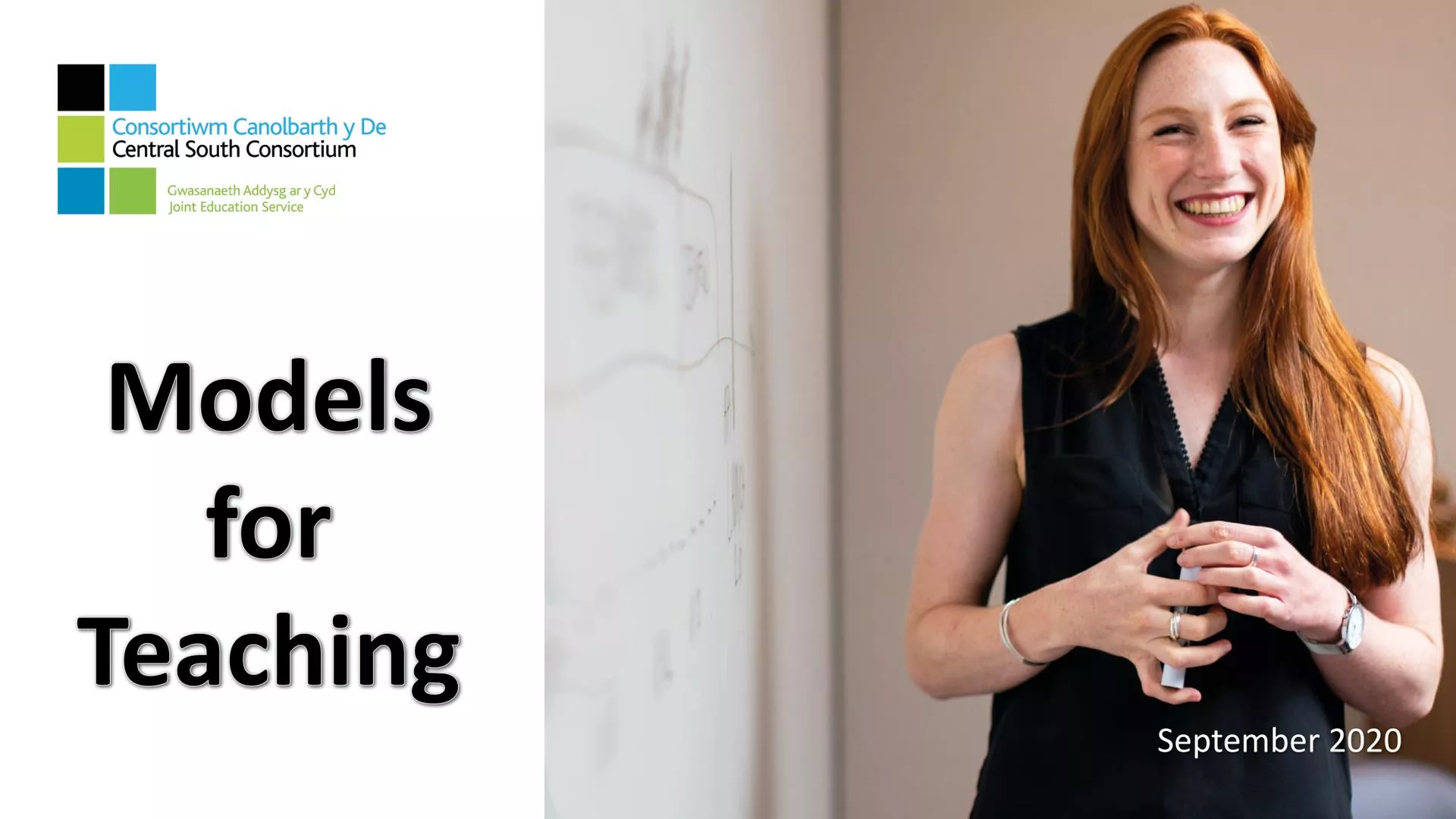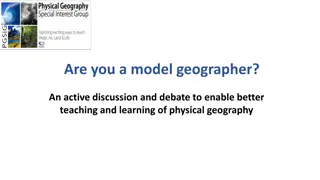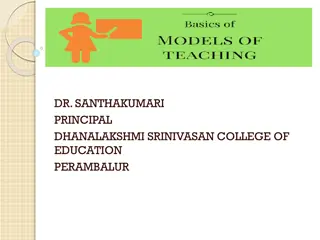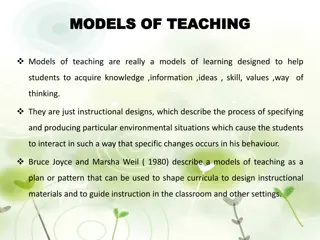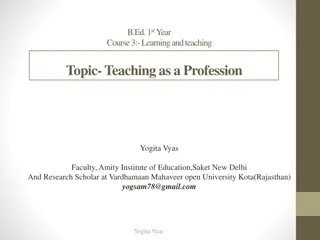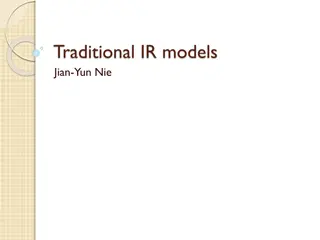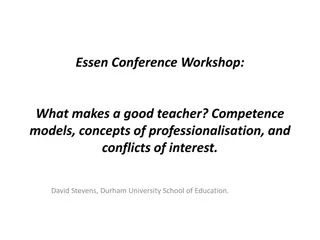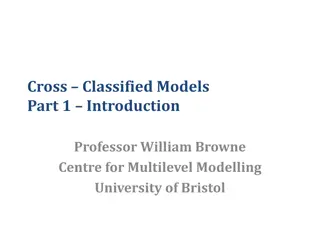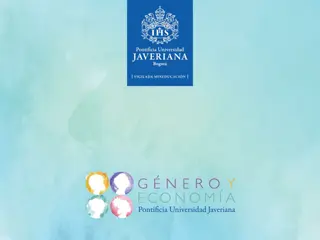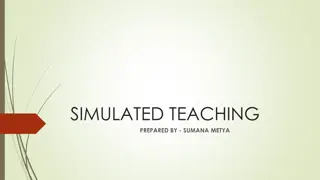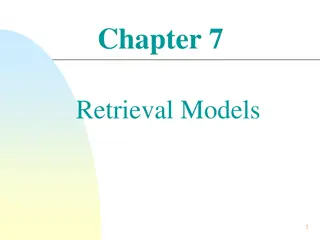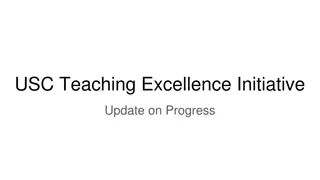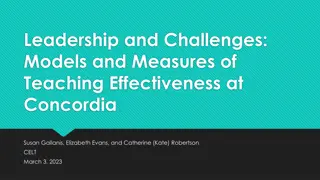Models for High-Quality Teaching: A Comprehensive Overview
Improving education is a critical national mission, emphasizing universal access to essential experiences and skills. Quality teaching is highlighted as a powerful lever in enhancing learner attainment. Various teaching models are explored to support consistency and effectiveness in educational practices. The document emphasizes the importance of understanding pedagogy, continuous improvement, research-informed decisions, and alignment with school vision. It serves as a valuable resource for school leaders and practitioners to make informed decisions regarding high-quality teaching approaches.
Download Presentation

Please find below an Image/Link to download the presentation.
The content on the website is provided AS IS for your information and personal use only. It may not be sold, licensed, or shared on other websites without obtaining consent from the author.If you encounter any issues during the download, it is possible that the publisher has removed the file from their server.
You are allowed to download the files provided on this website for personal or commercial use, subject to the condition that they are used lawfully. All files are the property of their respective owners.
The content on the website is provided AS IS for your information and personal use only. It may not be sold, licensed, or shared on other websites without obtaining consent from the author.
E N D
Presentation Transcript
Contents Contents Introduction p. 3 Models for teaching BSCS 5E Instructional Model Direct Instruction Experiential Learning Explicit Direct Instruction Five Episodes of Instruction Gradual Release of Responsibility Great Teaching Toolkit Making Every Lesson Count Mastery Teaching New Teacher's Companion Nine Events of Instruction Rosenshine's Principles of Instruction Student Learning That Works p. 5 p. 7 p. 9 p. 11 p. 13 p. 15 p. 17 p. 19 p. 21 p. 23 p. 25 p. 27 p. 29 Reference List p. 31 2
Introduction Introduction Improving education is our national mission. Nothing is so essential as universal access to, and acquisition of, the experiences, knowledge and skills and that our young people need for employment, lifelong learning and active citizenship. Schools should seek to develop a strong vision of learning and teaching which considers the why and how as well as the what . (Welsh Government, 2020) It is widely accepted, and has been cited in much educational research, that the singular most powerful lever in raising learner attainment is the quality of teaching. The Education Endowment Foundation (2020) stated, 'Alongside targeted interventions, improving the quality of teaching is the strongest lever schools have to improve pupil outcomes, particularly for disadvantaged students'. It is also true that to support high quality teaching a number of educationalists have provided 'models' that suggest a particular framework to achieve this. These models can be very helpful in providing a framework for a school to ensure consistency of approaches to teaching. They do however carry the risk of oversimplification of complex material or a surface level understanding of the principles that underpin them, and thus they can lose their original intention. 3
There must be a clear understanding by all practitioners that high quality teaching is not a formula. Rather that high quality teaching is: built on a clear understanding of pedagogy from leaders and practitioners; consistently applied across the schools; continually revisited for effectiveness; grounded in an understanding of why particular strategies have been trialled or are used; based on decisions that are directly linked to learner needs; research informed and evidence engaged, and linked to a clear and shared school vision which staff are empowered to realise. This document has been designed to collate and share information on a range of models for teaching in a readily accessible and comparable format to support school leaders and practitioners in making informed decisions about their schools' consistent approach to high quality teaching for all practitioners. A model should not be applied without considering the context in which each school operates, and it is likely that a school will evolve a model/s as it applies it based on feedback from staff and learners about what works well and evaluation of the impact on learning. In education at least, what works is generally the wrong question, because most ideas that people have had work in some contexts but not in others. Put bluntly, everything works somewhere and nothing works everywhere (Wiliam, D. 2018) 4
Stage or Phase 5E Instructional Model BSCS What the BSCS 5E Instructional Model is/does: The five phases of the BSCS 5E Instructional Model are designed to facilitate the process of conceptual change. The use of this model brings coherence to different teaching strategies, provides connections among educational activities, and helps science teachers make decisions about interactions with students. Each phase of the model and a short phrase to indicate its purpose from a student perspective are: Engagement - students' prior knowledge accessed and interest engaged in the phenomenon Exploration - students participate in an activity that facilitates conceptual change Explanation - students generate an explanation of the phenomenon Elaboration - students' understanding of the phenomenon challenged and deepened through new experiences Evaluation - students assess their understanding of the phenomenon Engage interest Engage Set goals for learning Guide new learning Explore Explain Consolidate and reflect on learning Elaborate Applying new learning Evaluate BSCS 5E Instructional Model https://bscs.org/bscs-5e-instructional-model/ 5 Hubbell, E R., Goodwin, B., (2019)
5 E Instructional Model ENGAGE: prior knowledge accessed and interest engaged in the phenomenon EXPLORE: participate in an activity that facilitates conceptual change EXPLAIN: learners generate an explanation of the phenomenon ELABORATE: understanding of the phenomenon challenged and deepened through new experiences EVALUATE: learners assess their understanding of the phenomenon 6
Stage or Phase Direct Instruction Engelmann Direct Instruction (DI) is a model for teaching that emphasizes well- developed and carefully planned lessons designed around small learning increments and clearly defined and prescribed teaching tasks. It is based on the theory that clear instruction eliminating misinterpretations can greatly improve and accelerate learning. Engage interest Introduce new concept/review prior learning Direct Instruction enables practitioners to identify and focus on what students know, what they don t understand yet, and where they need additional practice or support. Set goals for learning Guide new learning Present content with examples/non-examples There are five key philosophical principles and four main features of DI. Consolidate and reflect on learning Student response Learners are placed and grouped at their skill levels and taught to mastery. Groups should be homogeneous with respect to learners current performance level, and these groups should be flexible in order to incorporate different rates of student learning. Teacher feedback Applying new learning Independent practice Englemann's Direct Instruction (DI) https://www.nifdi.org 7 Hubbell, E R., Goodwin, B., (2019)
Introduce new concept/review prior learning. Make these faultless through communication that is logically flawless Present content with examples/non-examples Predict that the learner will learn the concept conveyed by the faultless presentation. Student response Observe whether the learner actually learns the intended concept or whether the learner has difficulty Direct Instruction Teacher feedback The extent to which the learner does or does not possess the mechanisms necessary to respond to the faultless presentation of the concept. Independent practice Design instruction for the unsuccessful learner that will modify the learner's capacity to respond to the faultless presentation 8
Kolb's Experiential Learning style theory is typically represented by a four-stage learning cycle in which the learner 'touches all the bases : Stage or Phase Experiential Learning Kolb Engage interest 1. Concrete Experience - a new experience or situation is encountered, or a reinterpretation of existing experience. Set goals for learning 2. Reflective Observation of the New Experience - of particular importance are any inconsistencies between experience and understanding. Guide new learning Concrete experience 3. Abstract Conceptualization reflection gives rise to a new idea, or a modification of an existing abstract concept (the person has learned from their experience). Reflective observation Consolidate and reflect on learning Abstract conceptualisation 4. Active Experimentation - the learner applies their idea(s) to the world around them to see what happens. Applying new learning Active experimentation Kolb's learning cycle https://www.simplypsychology.org/learning-kolb.html 9 Hubbell, E R., Goodwin, B., (2019)
CONCRETE EXPERIENCE (doing / having an experience) Experiential Learning REFLECTIVE OBSERVATION (reviewing / reflecting on the experience) ACTIVE EXPERIMENTATION (planning / trying out what you have learned) ABSTRACT CONCEPTUALISATION (concluding / learning from the experience) 10
Stage or Phase Explicit Direct Instruction (EDI) Hollingsworth & Ybarra Explicit Direct Instruction (EDI), an approach to learning based on the best research available, helps teachers deliver effective lessons that can significantly improve achievement for all learners, including English language learners and students with special needs. Engage interest Activate prior knowledge Set goals for learning Learning objective EDI was developed by DataWORKS founders, Dr. Silvia Ybarra and John Hollingsworth. EDI focuses on improving education at the lesson level by incorporating a strategic collection of instructional practices from the work of educational and cognitive researchers such as Hattie, Rosenshine, Hunter, Sousa, and Marzano. Guide new learning Concept development Skill development Consolidate and reflect on learning Guided practice In its most basic terms EDI teaches explicitly in small steps ensuring that pupils achieve success. Relevance Applying new learning Closure Explicit Direct Instruction https://dataworks-ed.com/trainings/edi/ 11 Hubbell, E R., Goodwin, B., (2019)
Activate prior knowledge Linking to prior learning Learning objective Transparent intentions and success criteria Concept development Modelling the why Explicit Direct Instruction Skill development Modelling the how Guided practice Developing fluency & correcting errors Relevance Independent practice / use Closure Reviewing and assessing the learning from the lesson 12
Five Episodes of Instruction Episode 1: Preparing Students for New Learning: Learning begins with attention. Therefore, during this episode, teachers capture students' attention and help students activate prior knowledge. Teachers also direct students' attention to the learning to come by establishing clear learning targets Episode 2: Presenting/Acquiring New Learning: Learning requires focus. Teachers do more than present content during this episode; they help students actively process the content and assemble information into big ideas and important details. Episode 3: Deepening and Reinforcing Learning: Learners need opportunities to consolidate learning. Therefore, during this episode, teachers engage students in strategic practice to help them solidify their understanding of key content and increase their mastery of new skills. Episode 4: Applying and Demonstrating Learning: Learners further consolidate and extend learning by applying it. Therefore, during this episode, teachers challenge students to demonstrate, synthesise, and transfer their learning. Episode 5: Reflecting on and Celebrating Learning: This entire process is enhanced through active reflection. Teachers help students look back on, learn from, and celebrate their learning and their learning process. Stage or Phase Five Episodes of Instruction Silver & Strong Engage interest Prepare students for new learning Set goals for learning Guide new learning Presenting new learning Consolidate and reflect on learning Deepening and reinforcing learning Applying new learning Applying learning Reflecting on and celebrating learning Five Episodes of Instruction http://www.ascd.org/ascd-express/vol13/Making-Lessons-Memorable- Designing-from-Two-Perspectives.aspx 13 Hubbell, E R., Goodwin, B., (2019)
Episode 1: Preparing Students for New Learning: Activate prior knowledge, establish clear learning targets Episode 2: Presenting/Acquiring New Learning: Help learners actively process the content and assemble information into big ideas and important details. Episode 3: Deepening and Reinforcing Learning: Engage learners in strategic practice to help them solidify their understanding of key content and increase their mastery of new skills. Episode 4: Applying and Demonstrating Learning: Teachers challenge students to demonstrate, synthesise, and transfer their learning. Episode 5: Reflecting on and Celebrating Learning: Teachers help learners look back on, learn from, and celebrate their learning and their learning process. Five Episodes of Instruction 14
Stage or Phase Gradual Release of Responsibility Fisher & Frey The Gradual Release of Responsibility model or GRR model is a particular style of teaching which is a structured method of pedagogy framed around a process devolving responsibility within the learning process from the teacher to the eventual independence of the learner. Engage interest This instructional model requires that the teacher, by design, transitions from assuming "all the responsibility for performing a task...to a situation in which the students assume all of the responsibility". Set goals for learning Focus lesson Guide new learning Guided instruction ( I do ) The ideal result is a confident learner who accepts responsibility for their own learning and directs this learning through the cognitive processes involved, moving through the academic spectrum, to independent choice (personalised learning). Consolidate and reflect on learning Guided instruction ( We do ) As Buehl (2005) stated, the GRR model, "emphasizes instruction that mentors students into becoming capable thinkers and learners when handling the tasks with which they have not yet developed expertise". Productive group work Applying new learning Independent learning ( You do ) Gradual release of responsibility https://en.wikipedia.org/wiki/Gradual_release_of_responsibility 15 Hubbell, E R., Goodwin, B., (2019)
Gradual Release of Responsibility Focus lesson Guided instruction Guided instruction Productive group work Independent learning ( I do ) ( We do ) ( You do it together ) ( You do ) 16
Great Teaching Toolkit Stage or Phase Great Teaching Toolkit Evidence Based Education The aim is to help teachers make better decisions about what they can best do to improve their effectiveness. Four priorities are stated for teachers who want to help their student learn more: 1. understand the content they are teaching and how it is learnt 2. create a supportive environment for learning 3. manage the classroom to maximise the opportunity to learn 4. present content, activities and interactions that activate their students thinking Engage interest Set goals for learning Understanding the context Creating a supportive environment A model that comprises these four overarching dimensions, with a total of 17 elements within them. An element is defined as something that may be worth investing time and effort to work on to build a specific competency, skill or knowledge, or to enhance the learning environment. There is no implication that the complexity of teaching can be reduced to a set of techniques, but evidence suggests the best route to expertise is likely to involve a focus on developing competencies, guided by formative feedback in a supportive professional learning environment. Guide new learning Maximise the opportunity to learn Consolidate and reflect on learning Applying new learning Activate hard thinking Great Teaching Toolkit https://www.greatteaching.com/ 17
Great Teaching Toolkit Activating hard thinking Structuring Maximise opportunities to learn Explaining Manage time and resources Creating a supportive environment Questioning Interactions and relationships Understand the content Interacting Positive climate Clear, consistent rules and expectations Deep subject knowledge Curriculum knowledge Embedding Learner motivation Assessment knowledge Activating Climate of high expectations Positive reinforcement Knowledge of strategies 18
Stage or Phase Making Every Lesson Count Allison & Tharby Making Every Lesson Count bridges the gap between research findings and classroom practice. Shaun Allison and Andy Tharby examine the evidence behind what makes great teaching and explore how to implement this in the classroom to make a difference to learning. They distil teaching and learning down into six core principles: challenge, explanation, modelling, practice, feedback and questioning, and show how these can inspire an ethos of excellence and growth, not only in individual classrooms but across a whole school. Engage interest Set goals for learning Challenge Guide new learning Explanation Combining robust evidence from a range of fields with the practical wisdom of experienced, effective classroom teachers, the book is a complete toolkit of strategies that teachers can use every lesson to make that lesson count. There are no gimmicky ideas here just high impact, focused teaching that results in great learning, every lesson, every day. Modelling Consolidate and reflect on learning Questioning Making Every Lesson Count offers an evidence-informed alternative to restrictive definitions of great teaching, empowering teachers to deliver great lessons and celebrate high-quality practice. Applying new learning Feedback Allison S. & Tharby A., (2015) 19
Expert teaching requires Challenge So that Learners have expectations of what they can achieve Explanation So that Learners acquire new knowledge and skills Modelling So that Learners know how to apply the knowledge and skills Students engage in deliberate practice Making Every Lesson Count Questioning So that Learners are able to think hard with breadth, depth and accuracy Scaffolding Feedback So that Learners think about and further develop their knowledge and skills 20
Mastery Teaching Stage or Phase Mastery Teaching Hunter A number of direct instruction strategies have been combined by Madeline Hunter into a single, relatively comprehensive approach that she calls mastery teaching (not to be confused with the related term 'mastery learning'). Engage interest Anticipatory set What happens even before a lesson begins? Like many forms of teacher- directed instruction, the model requires curricula and learning goals that are tightly organised and divisible into small parts, ideas, or skills. Set goals for learning Objective and purpose Once this analysis of the curriculum has been done, the Hunter's effective teaching model requires making the most of the lesson time by creating an anticipatory set, which is an activity that focuses or orients the attention of students to the upcoming content. Guide new learning Input Modelling Consolidate and reflect on learning Checking for understanding Throughout a lesson, the teacher repeatedly checks for understanding by asking questions that call for active thinking on the part of students. Guided practice As a lesson draws to a close, the teacher arranges for students to have further independent practice. The point of the practice is not to explore new material or ideas, but to consolidate or strengthen the recent learning. Applying new learning Independent practice Mastery teaching https://uk.sagepub.com/en-gb/afr/madeline-hunters-mastery- teaching/book225807?id=51755 Closure 21 Hubbell, E R., Goodwin, B., (2019)
Mastery teaching Input: Anticipatory set: Short motivating activity to focus learners Explaining concepts and skills Learning objective: Shared with learners Check Guided practice: Demonstrating skill or concept with immediate feedback Independent Study: Solidify skills and knowledge understanding: Multi level questioning 22
New Teacher's Companion Phase 1: Introduction Set a purpose. Introduce the key concepts, topic, main idea. Pull students into the excitement of learning. Make the learning relevant. Stage or Phase New Teacher s Companion Cunningham Phase 2: Foundation Check on previous knowledge. Clarify key points. Focus on specific standards, objectives, goals. Check for correctness and add to background knowledge. Introduce key vocabulary. Engage interest Introduction Set goals for learning Foundation Phase 3: Brain Activation Ask questions to clarify ideas and to add knowledge. Brainstorm main ideas. Clarify and correct misconceptions. Guide new learning Brain activation Phase 4: Body of New Information Provide teacher input. Body of new information Phase 5: Clarification Check for understanding with sample problems, situations, questions. Consolidate and reflect on learning Clarification Phase 6: Practice and Review Provide time for practice and review. Practice and review Phase 7: Independent Practice Supervise students' independent practice. Applying new learning Independent practice Phase 8: Closure Bring the lesson to closure. Closure New teacher s companion http://www.ascd.org/Publications/Books/Overview/The-New-Teachers- Companion.aspx 23 Hubbell, E R., Goodwin, B., (2019)
Phase 1: Introduction Set a purpose. Introduce the key concepts, topic, main idea. Pull students into the excitement of learning. Make the learning relevant. Phase 3: Brain Activation Ask questions to clarify ideas and to add knowledge. Brainstorm main ideas. Clarify and correct misconceptions. Phase 5: Clarification Check for understanding with sample problems, situations, questions Phase 7: Independent Practice Supervise students' independent practice. . Phase 6: Practice and Review Provide time for practice and review. Phase 2: Foundation Check on previous knowledge. Clarify key points. Focus on specific standards, objectives, goals. Check for correctness and add to background knowledge. Introduce key vocabulary. Phase 4: Body of New Information Provide teacher input. Phase 8: Closure Bring the lesson to closure. New Teacher's Companion 24
Stage or Phase Nine Events of Instruction Gagn Nine Events of Instruction Robert Gagne was an educational psychologist who created a 9 step process called 'Events of Instruction'. Engage interest Gaining attention Set goals for learning Informing the learner of the objective This model is a systematic process that helps educators and instructional designers develop strategies and create activities for training sessions Guide new learning Stimulating recall of prerequisite learning Presenting the stimulus material Providing learning guidance Consolidate and reflect on learning Eliciting the performance Providing feedback Assessing the performance Applying new learning Enhancing retention and transfer Nine events of instruction https://mylove4learning.com/robert-gagne-and-the-9-events-of- instruction/ 25 Hubbell, E R., Goodwin, B., (2019)
Nine Events of Instruction Enhance retention and transfer Provide feedback Gain attention Stimulate recall of prior learning Provide guidance Inform learners of objectives Present the content Elicit Assess performance performanc e 26
Principles of Instruction Rosenshine Stage or Phase Rosenshine s Principles of Instruction Begin a lesson with a short review of previous learning. Present new material in small steps with student practise after each step. Ask a large number of questions and check the responses of all students. Provide models. Guide student practice. Check for student understanding. Obtain a high success rate. Provide scaffolds for difficult tasks. Require and monitor independent practice. 10. Engage students in weekly and monthly review. 1. 2. Begin a lesson with a short review of previous learning. Engage interest 3. Present new material in small steps with student practise after each step. Set goals for learning 4. 5. 6. 7. 8. 9. Ask a large number of questions and Guide new learning check the responses of all students. Provide models. Guide student practice. Provide scaffolds for difficult tasks. Do the principles all apply to every lesson? It is very important not to think of the Principles as some kind of lesson plan. Different lessons in a learning sequence will require a different focus: some might have more explanatory modelling; more questioning or more independent practice. You might have whole lessons of practice and whole lessons of teacher modelling and questioning. You might not literally do daily review every day. However, over a series of lessons that relate to a secure sequence, you might expect all elements of the Principles to feature in some form. Require and monitor independent practice. Check for student understanding. Consolidate and reflect on learning Obtain a high success rate. Engage students in weekly and monthly review Applying new learning Rosenshine s Principles https://teacherhead.com/2019/10/02/rosenshines- principles-10-faqs/ 27 Sherrignton, T. (2019)
Guide student practice. Begin a lesson with a short review of previous learning. Present new material in small steps with student practise after each step. Provide models. Ask a large number of questions and check the responses of all students. Provide scaffolds for difficult tasks. Engage students in weekly and monthly review. Require and monitor independent practice. Check for student understanding. Obtain a high success rate. Rosenshine s Principles of Instruction 28
Student Learning that Works Stage or Phase Student Learning That Works McRel A learning model would describe the learning process from beginning to end from the moment a new bit of knowledge first enters a student s consciousness through the long and perilous journey it must take before finding a permanent home in their long-term memory (Sousa, 2011). Such a model would help us to design effective learning experiences for all students. And, just as important, if they re not learning, the model can help us figure out where the blockage or breakdown may be occurring where the knowledge is getting lost on its journey. Engage interest Become interested Set goals for learning Commit to learning Guide new learning Focus on new learning McREL propose not another framework, but a synthesis of the science of learning into a model you can follow and apply right away in your classroom. Not offered as the only way to teach, but rather as one way to develop more expert practice in your classroom. Consolidate and reflect on learning Make sense of learning Rehearse and reflect An important 'flip' happens when we design lessons around learning not simply teaching Applying new learning Extend and apply Student Learning That Works https://www.mcrel.org/student-learning-that-works-wp/ 29 Hubbell, E R., Goodwin, B., (2019)
Become Interested: Stimuli in out sensory register catch our attention Commit to Learning: We determine the stimuli worthy of further attention Focus on new knowledge: We focus on new knowledge and skills while they re in our working memory Make sense of learning: Clustering and linking knowledge to prior learning Practice and Rehearse: Repetition and retrieval to help us store new learning in long-term memory Extend and apply: Apply new learning in novel meaningful ways supports retrieval Student Learning that Works 30
Reference List Reference List Allison, S. & Tharby, A. (2015). Making Every Lesson Count, Crown House Publishing Ltd, Wales ASCD (2020). Making Learning Memorable, Available from http://www.ascd.org/ascd-express/vol13/Making-Lessons- Memorable-Designing-from-Two-Perspectives.aspx [Accessed 11 August 2020] BSCS Science Learning (2020). BSCS 5E Instructional Model, Available from: https://bscs.org/bscs-5e-instructional- model/ [Accessed 11 August 2020] Cunningham, G. (2009). The New Teacher s Companion: Practical Wisdom for Succeeding in the Classroom, ASCD, Alexandria, VA DataWORKS Educational Research (2020). Explicit Direct Instruction Workshop, Available from https://dataworks- ed.com/trainings/edi/ [Accessed 11 August 2020] Evidence Based Education (2020). Great Teaching Toolkit, Available from https://www.greatteaching.com [Accessed 11 August 2020] Hubbell, E. R., Goodwin, B. (2019). Instructional Models How to Choose One and How to Use One. McRel International, Denver. 31
Hunter, M. (2004). Mastery Teaching: Increasing Instructional Effectiveness in Elementary and Secondary Schools, (Second Edition), Santa Susana Elementary School, Simi Valley, CA McREL International (2018) White Paper: Student Learning That Works: How brain science informs a student learning model, Available from https://www.mcrel.org/student-learning-that-works-wp/ [Accessed 11 August 2020] My Love 4 Learning (2019). Robert Gagne and the 9 Events of Instruction, Available from https://mylove4learning.com/robert-gagne-and-the-9-events-of-instruction/ [Accessed 11 August 2020] National Institute for Direct Instruction (2020). The Gold Standard in Direct Instruction, Available from: https://www.nifdi.org [Accessed 11 August 2020] Sherrington, T. (2019). Rosenshine s Principles in Action, John Catt Education Ltd, Woodbridge Simply Psychology (2020). Kolb s Learning Styles and Experiential Learning Cycle, Available from: https://www.simplypsychology.org/learning-kolb.html [Accessed 11 August 2020] Teacherhead (2019). Rosenshine s Principles: 10 FAQs, Available from https://teacherhead.com/2019/10/02/rosenshines-principles-10-faqs/ [Accessed 11 August 2020] 32
Welsh Government (2020). Curriculum for Wales, Available from: https://hwb.gov.wales/curriculum-for- wales/introduction/ [Accessed 11 August 2020] Welsh Government (2020). Curriculum for Wales, Available from: https://hwb.gov.wales/curriculum-for- wales/designing-your-curriculum/implementation-and-practical-considerations/#pedagogy [Accessed 11 August 2020] Wikipedia (2020). Gradual Release of Responsibility, Available from https://en.wikipedia.org/wiki/Gradual_release_of_responsibility [Accessed 11 August 2020] Wiliam, D. (2018). Creating The Schools Our Children Need, Learning Sciences International, West Palm Beach 33


